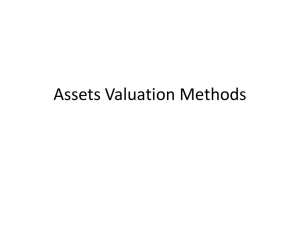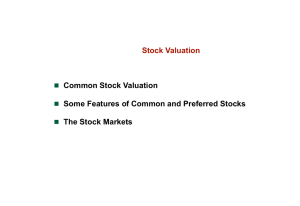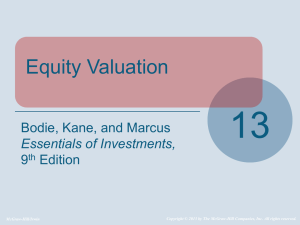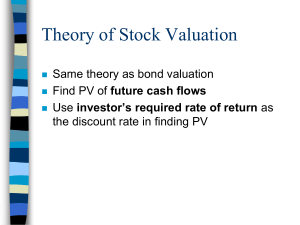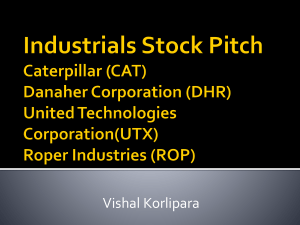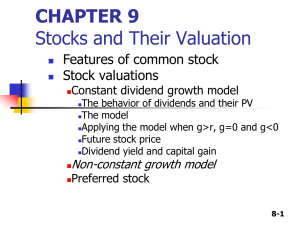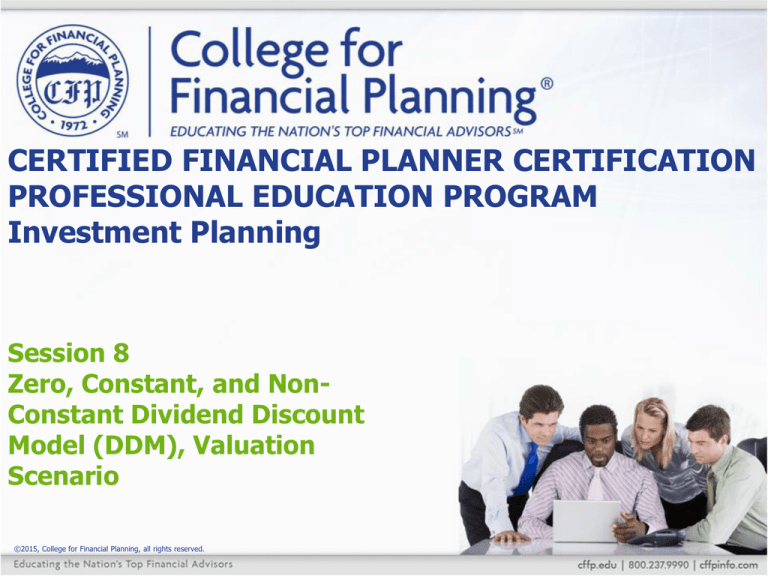
CERTIFIED FINANCIAL PLANNER CERTIFICATION
PROFESSIONAL EDUCATION PROGRAM
Investment Planning
Session 8
Zero, Constant, and NonConstant Dividend Discount
Model (DDM), Valuation
Scenario
©2015, College for Financial Planning, all rights reserved.
Session Details
Module
4
Chapter(s) 2
LOs
4-2
Explain terminology related to equity
investment valuation models.
4-3
Calculate the intrinsic value of a stock using
various stock valuation techniques or calculate
the expected return of a stock.
4-4
Evaluate the appropriateness of investment
decisions based on stock valuation models.
8-2
Required Return (r)
r rf (rm rf )β
8-3
Expected Return
D1
E(r)
g
P
8-4
Constant Growth DDM
D1
V
r g
8-5
Dividend Growth Rate (g)
g ROE RR
8-6
Valuation Approaches
• Dividend Discount
•
•
•
•
Model
Price/Earnings Ratio
Price/Book Ratio
Price/Sales Ratio
PE/Growth (PEG)
Ratio
8-7
Valuation
• The determination of what a stock is worth;
•
•
the stock's intrinsic value
If the valuation exceeds the price, buy the
stock.
If the valuation is less than the price, do not
buy or short the stock.
8-8
Zero Growth Model
• Used when you have dividends into perpetuity,
•
in which the dividend is fixed
Use for preferred stocks
D0
V
r
Example: Lightning Enterprises Preferred pays a
$1.50 dividend and yields are currently 6%.
1.50/.06 = $25.00
8-9
Constant Growth: Example
Thor Industries pays an annual dividend of
$2.00 per share, and its dividends are expected
to grow at
6% annually.
If your required return is
intrinsic value of Thor?
10%, what is the
2.00(1.06)
V
$53.00
.10 .06
8-10
Constant Growth: Example
Fair Market Value
Less than $53
$53
Greater than $53
Relative Value
Undervalued
Fairly valued
Overvalued
Action
Buy
Buy
Do not buy
or sell short
8-11
Expected Return
2.00(1.06)
E(r)
.06 .1024 10.24%
50
2.00(1.06)
E(r)
.06 .10 10%
53
2.00(1.06)
E(r)
.06 .0979 9.79%
56
8-12
Valuation Scenario
Stock VIP sells for $50 and pays an annual
dividend of $3.00; its dividends are expected to
increase by 3% annually.
The stock has a beta of .85. The required rate of
return on the market is 10%, and the risk-free rate
is 5.5%.
a. What is the investor’s required rate of return?
r rf (rm rf )β
= 5.5 + (10 – 5.5) .85
= 5.5 + 3.83
= 9.33%
8-13
Valuation Scenario
b. What is the intrinsic value of Stock VIP?
D1
$3.00(1.03)
V
$48.82
r g .0933 .03
8-14
Valuation Scenario
c. What is the expected rate of return on
Stock VIP?
D1
E(r)
g
P
= $3.09 + .03
$50
= 9.18%
8-15
Valuation Scenario
Stock VIP is trading at $50 and its intrinsic value is
$48.82.
Would you buy the stock?
No, it is overvalued.
When a stock is overvalued the expected return
(9.18% for VIP) will be less than the required
return (9.33% for the VIP investor).
8-16
Expected Return
• Stock Overvalued:
Expected return less
than required return
• Stock Undervalued:
Expected return more
than required return
8-17
Non-Constant Growth DDM
• Uses more than one growth rate, with a higher growth
•
rate initially, and then a lower rate as the company
matures
Calculation requires the use of the cash flow key (CFj)
on the financial calculator
Note: With HP12c, always use the CFo key first, then
the CFj key.
8-18
Non-Constant Growth DDM Calculation
Travis is interested in buying a stock that
currently pays a dividend of $0.60 cents per
share annually. His required return on
investments is 9%. The dividend is expected
to grow 15% annually for the next two years,
followed by an expected growth rate of 6% thereafter.
What is the most that Travis should pay for the stock?
Step 1: Find the amount of the dividend at the end of
each of the two years of the non-constant growth:
0.60 x 1.15 = 0.69
0.69 x 1.15 = 0.7935
8-19
Non-Constant Growth DDM Calculation
Step 2: Find the value of the stock at the end of
Year 2 based on the dividend to be paid at the end of Year
3 (constant growth):
0.7935 (1.06) = $28.04
0.09 - 0.06
Step 3: Using the calculator, solve for the
PV of unequal cash flows using the timeline.
8-20
Non-Constant Growth Timeline
8-21
P/E Ratio & PEG Ratio
Price/Earnings ratio:
Current stock price
Current (or projected) earnings per share
PEG ratio:
Current P/E ratio
Current y ear earnings growth rate
8-22
PSR & P/B Ratio
Price to Sales ratio:
Current stock price
Sales per share
Price to Book ratio:
Current stock price
Book v alue per share
8-23
Question 1
If the risk premium in the CAPM equation for a
stock decreases, what is the likely consequence
of the valuation of the stock when the dividend
growth model is used to compute its value?
a. The stock’s value will increase.
b. The stock’s value will not change.
c. The stock’s value will decrease.
d. The risk premium is not relevant to the
CAPM.
8-24
Question 2
You are researching a company that retains all of
its earnings, and has no immediate plans to pay a
dividend. It has a positive cash flow, but negative
earnings per share for the past two years.
Which one of the valuation approaches would you
consider when analyzing the company?
a. constant growth dividend discount model
b. PSR
c. PEG ratio
d. P/E ratio
8-25
Question 3
Fiona, age 35, needs income and is considering the purchase
of a preferred stock that pays $1.75 in annual dividends. The
preferred stock is currently trading at $29 per share. Your
research shows that other preferred shares with comparable
ratings are currently yielding 7%.
You would advise Fiona to
a. purchase the shares; they appear to be fairly priced at
$29 per share.
b. purchase the shares; they are undervalued since they
have an intrinsic value of $32 per share.
c. not purchase the shares, they are overvalued since they
have an intrinsic value of $25 per share.
d. not purchase the shares; she is too young to be
purchasing preferred stock.
8-26
Question 4
Your client is considering a purchase of Titan Industries,
and you are helping the client evaluate the stock. This
past year the company earned $3.00 a share, and paid
out 25% of its earnings as dividends. Titan expects
both dividends and earnings to grow at 5% for the
foreseeable future, and it expects the payout ratio to
remain at 25%. Your required rate of return is the
current 10-year Treasury note rate of 6%, plus a risk
premium of 6%.
What is the intrinsic value of Titan Industries?
a. $11.25
b. $28.55
c. $45.00
d. $78.75
8-27
Question 5
You are evaluating Retro Holdings, Inc., for a
possible purchase. Last year it paid $1.00 in
dividends, and you expect the dividend to grow at a
rate of 12% for the next three years, and then
grow at 6% thereafter. Your required return is 9%.
What is the maximum amount you should pay for
the stock?
a. $35.33
b. $41.50
c. $45.22
d. $47.86
8-28
Question 6
Echo Echo Inc. sells for $79 per share and pays an annual
dividend of $2.48. The price and dividend is expected to
increase by 5% annually.
Using the constant growth dividend discount model for
valuation, and assuming an investor has a required rate of
return of 8%, which of the following are true statements?
I. The expected rate of return is greater than the required
rate of return.
II. The expected rate of return is less than the required rate
of return.
III. The stock is undervalued.
IV. The stock is overvalued.
a. I and II only
b. I and III only
c. I and IV only
d. II and III only
8-29
Question 7
A stock has a current price of $66, earnings of $1.70, and
pays out a dividend of $0.75. The stock’s historical P/E range
is 18 to 26.
Which of the following are correct statements about the
stock’s P/E ratio, valuation, and possible future action?
I. P/E = 39
II. P/E = 88
III. stock is overvalued, downward pressure expected
IV. stock is undervalued, upward pressure expected
a. I and III only
b. I and IV only
c. II and III only
d. II and IV only
8-30
CERTIFIED FINANCIAL PLANNER CERTIFICATION
PROFESSIONAL EDUCATION PROGRAM
Investment Planning
Session 8
End of Slides
©2015, College for Financial Planning, all rights reserved.




